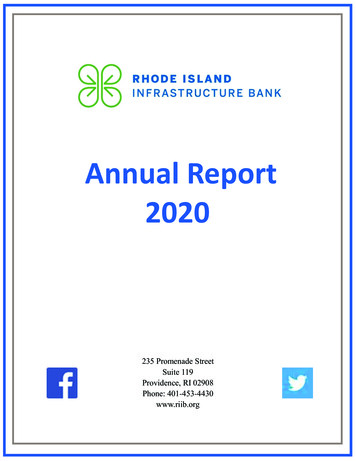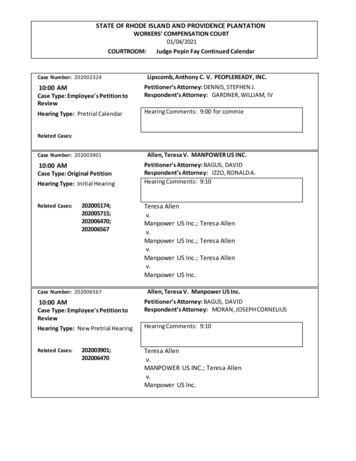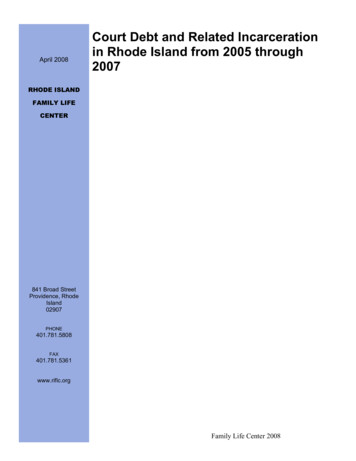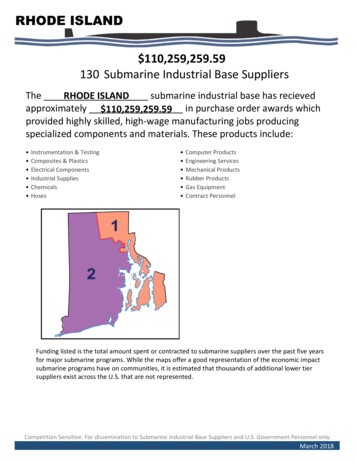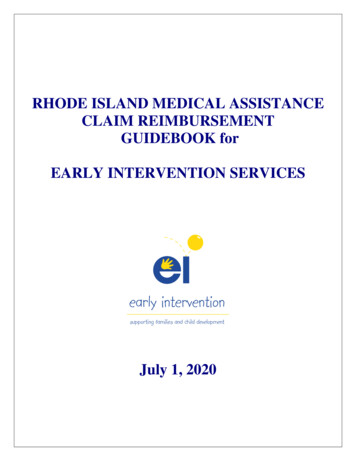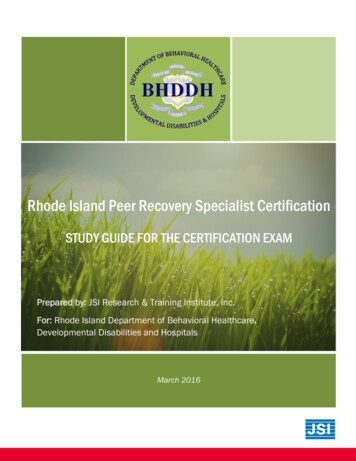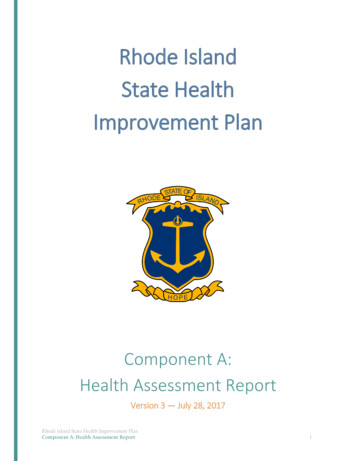
Transcription
Rhode IslandState HealthImprovement PlanComponent A:Health Assessment ReportVersion 3 — July 28, 2017Rhode Island State Health Improvement PlanComponent A: Health Assessment Report1
Rhode Island State Health Improvement PlanSection One: Health Assessment ReportTable of ContentsAcknowledgements .4Preface .5Organization of the Plan . 6Health Assessment Report Introduction .8Overview . 8Report Purpose . 8Background . 8Defining Population Health . 10Measuring Population Health.11State Innovation Model (SIM) Health Focus Areas . 12Health Focus Areas Defined .12Focus Area Alignment with State Priorities .13Integrating Physical and Behavioral Health within Focus Areas .14Statewide Health Equity Indicators . 16Defining Rhode Island’s Health Equity Domains and Key Determinants .17Health Equity Spotlight: Rhode Island’s Homeless Community .17Assessment of Population Health Burden . 19A Snapshot of Rhode Island’s Health . 19Life Expectancy and Potential Years Lost .19Health-Related Quality of Life .20Summary of Physical and Behavioral Health Burdens . 22Physical Health Morbidity .22Behavioral Health Morbidity .23Co-morbidity and Co-occurrence .24Co-occurrence and the Health Planning Process .25Costs of Healthcare in Rhode Island . 27Assessment of Selected Health Focus Areas . 29Obesity: Health Focus Area 1 . 31Chronic Diseases: Health Focus Area 2 . 36Diabetes .36Heart Disease and Stroke (Cardiovascular Diseases).41Rhode Island State Health Improvement PlanComponent A: Health Assessment Report2
Tobacco Use: Health Focus Area 3 . 46Opioid Use Disorders: Health Focus Area 4 . 53Maternal Child Health: Health Focus Area 5 . 61Pregnant Mothers .61Maternal Child Health Spotlight: Infants Born at Highest Risk .64Infants .65Maternal Child Health Spotlight: Fetal Alcohol Spectrum Disorders .71Children.72Maternal Child Health in Other Sections of this Report .74Children with Social and Emotional Disturbance: Health Focus Area 6 . 75Depression: Health Focus Area 7 . 82Serious Mental Illness: Health Focus Area 8 . 91Conclusion . 99Moving Population Health Forward in Rhode Island. 100Future Directions for Rhode Island’s Health Assessment Report . 100Institutionalizing a Multi-Agency Population Health Planning Process . 101Appendix 1: Convergence of Trends and Local Assessments . 103Local Community Assessments . 104Hospital Association of Rhode Island’s (HARI) Community Health Needs Assessments (2013 and2016) . 105Lifespan Community Health Needs Assessments (2016) . 109RIDOH Health Equity Zone Community Needs Assessments (2015) . 110Findings from Other State Plans and Key Reports . 115Rhode Island State Healthcare Innovation Plan (2013) . 115Rhode Island Coordinated Chronic Disease Prevention and Health Promotion Plan (2013) . 118Rhode Island Health Assessment and Health Improvement Plan (2014) . 120Statewide Health Inventory (2015) . 122Rhode Island Children’s Cabinet Strategic Plan (2015) . 125Rhode Island Commission for Health Advocacy and Equity Legislative Report (2015). 127Reinventing Medicaid Report (2015) . 129Rhode Island Behavioral Health Project: The Truven Report (2015) . 131Combined Substance Abuse/Mental Health Assessment Plan (2015) . 133Rhode Island Healthy Aging Data Report (2016) . 136Appendix 2: References . 138Rhode Island State Health Improvement PlanComponent A: Health Assessment Report3
AcknowledgementsThe development of this Health Assessment Report, sponsored by the Rhode Island State Innovation Model(SIM) Test Grant, was only made possible because of the important contributions and guidance providedby several key partners, including the public. The dedication and commitment of all those involved withthis endeavor was remarkable and deserves recognition. SIM would like to formally acknowledge thefollowing groups for the leadership and hard work provided to create this version of the Health AssessmentReport: SIM Integrated Population Health Planning Team, including staff and consultants fromDataSpark, the SIM Core Staff Team, the Technical Assistance Collaborative, and the Universityof Massachusetts Medical School;SIM Integrated Population Health Public Workgroup, made up of stakeholders from a varietyof organizations representing the health system, all of which are committed to improving healthin Rhode Island;Health Focus Area Subject-Matter Experts, including both programmatic and analytical stafffrom the Rhode Island Department of Behavioral Healthcare, Developmental Disabilities, andHospitals (BHDDH) and the Rhode Island Department of Health (RIDOH);Partner Data Providers, comprised of various programs and organizations that operate the manysurveillance or data systems and generate the key reports leveraged for this report;Integrated Population Health Review Team, with researchers from Brown University and theUniversity of Rhode Island; andSIM Steering Committee and Interested Parties, who are the community and state decisionmakers who guide and advise SIM’s work.Lastly, a special thanks to the state agency leadership from the Rhode Island Executive Office of Healthand Human Services (EOHHS), including the Division of Medicaid; BHDDH; the Rhode IslandDepartment of Children, Youth, and Families (DCYF); RIDOH; the Rhode Island Office of the HealthInsurance Commissioner (OHIC); and HealthSource RI.Rhode Island State Health Improvement PlanComponent A: Health Assessment Report4
PrefaceRhode Island’s first iteration of the Integrated Population Health Plan (IPHP) was initially created to meet theneeds of the Rhode Island State Innovation Model (SIM) Test Grant. An early version of the IPHP wasincluded in the SIM Operational Plan that was submitted in June 2016 to the Centers for Medicare andMedicaid Services (CMS). As the SIM Operational Plan is compiled from a range of relevant informationabout the State’s health needs and priorities, SIM’s leadership believes that the State Health Improvement Planshould also be a useful “living document” designed to inform ongoing state population health planningefforts. Moving forward, this plan will be referred to as the Rhode Island State Health Improvement Plan—astatewide centralized repository of source documents for population health planning.Living documents can be updated and expanded on an ongoing basis, and indeed, the State expects thisreport to meet a wide range of requirements of the varied stakeholders engaging in population healthplanning. This approach will allow Rhode Island to revise this document iteratively to reflect changes inassessment data, policy environment, emerging priorities, funded activities supporting population health(including those of SIM), ongoing surveillance recommendations, and agency-specific activities alignedwith improving population health in Rhode Island. This approach furthers Rhode Island’s culture ofcollaboration and enhances the State’s ability to have a cross-sector impact on population health.To reiterate, conceptualizing the Rhode Island State Health Improvement Plan as a living document is idealbecause it can be updated and referenced, as needed, for multiple needs across State and local agencies. Forexample, this section of the Rhode Island State Health Improvement Plan (i.e., Health Assessment Report) willserve as the Community Health Assessment requirements for the Public Health Accreditation Board andas components of Rhode Island’s legislatively mandated State Health Plan.Rhode Island State Health Improvement PlanComponent A: Health Assessment Report5
Organization of the PlanThe plan is made up of four distinct, stand-alone components that can easily be updated, printed, andreferenced over time. The four components are: Component A: Health Assessment ReportWhat Are Some of Our Health Problems?This component (represented by this document) provides an initial profile of eight aligned healthfocus areas across the State’s and community partners’ assessments. This component serves as acommunity health assessment of Rhode Islanders, within which more health focus areas can beadded. Profiles include historic trends, existing disparities, co-occurrences and co-morbiditiesbetween physical and behavioral health conditions, considerations across the life span, and, whereapplicable, attributed costs. These profiles inform Rhode Island’s population health planningefforts. Component B: Population Health StrategyWhat Are Our Goals and How Are We Organizing?This component will encompass the State’s leading priorities, core strategies, and integratedpopulation health goals (inclusive of key metrics) for improving population health. Specifically,this component will articulate a commitment to developing the culture of collaboration acrossagencies and ensuring the collective impact required to improve population health outcomes forRhode Islanders. Emphasizing the current and future states of Rhode Island’s approach toimproving population health, this component will delineate the roles that health systemtransformation, social and environmental determinants of health, and integrated physical andbehavioral health have in improving health and addressing disparities. Component C: Health Improvement PlanWhat Are We Doing to Achieve Our Goals?This component will provide specific details on the State’s integrated population health goals,organizing and delineating agency-specific key investments, activities (including SIMinterventions and others) that are essential to making health improvements a reality in RhodeIsland. This component will also include a robust set of intermediate measures used to set targetsfor and assess progress toward implementation of key investments. This component is essentiallya multi-agency, cross-sector action plan for improving population health. Component D: Performance Monitoring UpdatesHow Will We Know and Demonstrate How We Are Doing?This component will provide a variety of annual progress updates and reports reflecting theperformance of key investments toward reaching the State’s population health goals. Using thekey metrics, intermediate measures, and other quantitative/qualitative reports, this evaluation ofRhode Island’s approach toward improving population health will provide a continualRhode Island State Health Improvement PlanComponent A: Health Assessment Report6
opportunity for quality improvement. Every five years (or other designated period of time), thiscomponent will also inform future iterations of the Rhode Island State Health Improvement Plan.Together, these four components represent the essential elements necessary for coordinated populationhealth management in Rhode Island. By describing the health status of Rhode Islanders, outlining theState’s strategic priorities, depicting the vast landscape of current health improvement efforts, andmaintaining accountability for implementation of improvement efforts, the Rhode Island State HealthImprovement Plan can further the State’s ability to have a positive impact on population health. This plan isthe integration of population health planning within healthcare transformation and will ensure alignmentand sustainability of current and planned efforts across Rhode Island’s institutions and with the broadestdiversity of stakeholders.Figure 0: Integrated Population Health Planning CycleRhode Island State Health Improvement PlanComponent A: Health Assessment Report7
Health Assessment Report IntroductionOverviewThis report contains the information and data that have been collected, analyzed, and reported to informRhode Island’s population health priorities, referred to as “health focus areas.” Originally issued in thespring of 2016, two subsequent iterations of the original Integrated Population Health Plan (IPHP) havesince been published. This newest publication includes only the Health Assessment Report portion of theoriginal IPHP and has been expanded to include several new features: Addition of a new health focus area entitled Maternal and Child Health;Expansion of the health focus area entitled Tobacco to include data beyond smoking;Inclusion of data for health focus areas that represent various age ranges across the life span, whereavailable;Alignment of findings with those from other key reports and past assessments; andRepresentation of co-occurrence and co-morbidity, where applicable, across health focus areas.Report PurposeThis Health Assessment Report identifies and describes Rhode Island’s health needs and priorities, asidentified by State officials and Rhode Island’s many stakeholders. The Report includes informationcollected by various population health efforts underway in Rhode Island, such as the State InnovationModel (SIM) Test Grant, Health Equity Zone initiative, Accountable Care Organizations and AccountableEntities, and other local activities. The eight specific health focus areas represent only part of a larger effortto create and instill a culture of collaboration for improving population health.BackgroundRhode Island’s goal is to achieve the Triple Aim of improving the quality of care and patient satisfaction,enhancing the overall health of Rhode Island’s population, and spending healthcare dollars more wisely(See Figure 11).Figure 1: Rhode Island’s Triple Aim.Source: Adapted from The Institute for Healthcare ImprovementRhode Island State Health Improvement PlanComponent A: Health Assessment Report8
Thus, the State is assessing and addressing the opportunities that can make measurable improvements inthe health and productivity of all Rhode Islanders.In order to achieve the State’s goal, the healthcare delivery, public health, behavioral health, communitydevelopment, and social service sectors must work together and collaborate with the State’s manyacademic, public, and private institutions to ensure that all Rhode Islanders reach their highest healthpotential, regardless of who they are or where they live. To remove the systemic and structural barrierswithin the healthcare delivery system that can inhibit population health improvement, the State needs amulti-sector and multi-agency approach to help Rhode Island transition from an uncoordinated, providerand payer-centric care environment to a well-coordinated and integrated health system. In this newapproach, public health, behavioral health, social service, and healthcare delivery systems are efficientlycoordinating person-centric care while continuously providing higher quality services, reducing the costof care, and improving population health outcomes.Rhode Island State Health Improvement PlanComponent A: Health Assessment Report9
Defining Population HealthThe term population health encompasses both physical and behavioral health. The term physical healthrefers to the health of the various body systems, including oral health, and behavioral health refers to theinclusion of both mental health and substance use. Rhode Island’s approach to improving populationhealth addresses health needs across a population’s lifecourse, from pre-conception to death. Thisapproach views health from the perspective of the whole person, including a focus on both the mind andthe body, as behavioral health and well-being are instrumental in creating healthy, resilient, and productivecommunities. Figure 22 below provides examples of how various agencies define health.Figure 2: Various Definitions of Health.Sources: World Health Organization; Rhode Island Department of Health; Centersfor Disease Control and PreventionThere are many definitions for, and perspectives on, health. Health is not merely the absence of disease, butthe state of complete physical, mental, and social well-being, including the “ability to adapt and to selfmanage in the face of social, physical, and emotional challenges.” 3 Health is considered a resource foreveryday life and is created where we live, learn, work, and play. Population health, specifically, refers tothe aggregation of health outcomes for a group of individuals selected on specific characteristics (such asgeography, care setting, and health status) and includes the distribution of such outcomes within andacross groups to address racial, ethnic, socioeconomic, and other disparities.4,5Many factors impede an individual’s ability to achieve optimal health or to obtain the healthcare he or sheneeds. Throughout the lifecourse, these factors may gradually accumulate through exposures to adverseenvironmental and social conditions, behaviors that increase disease risk, or episodes of illness.6 Due toinequitable distribution of these factors, Rhode Island’s ability to monitor and ensure health equity isessential to improving population health.Rhode Island State Health Improvement PlanComponent A: Health Assessment Report10
Measuring Population HealthWhen defining population health, it is essential to focus on the role played by various health determinantsacross the lifecourse. Population health planning must consider multi-factor, developmental, andlifecourse perspectives that recognize the critical importance of early life and childhood experiences, theaccumulation of exposures across the lifetime, and person-context interactions. The figure below depictsthe conceptual model of population health using a determinant and life course framework.Figure 3: Model of Population Health.Source: Adapted from Bharmal, N. et al. (2015)7Rhode Island State Health Improvement PlanComponent A: Health Assessment Report11
State Innovation Model (SIM) Health Focus AreasThe State has identified eight health focus areas across sectors, geographies, programs, and assessmentsthat align with the SIM Test Grant’s population health and system transformation activities. This HealthAssessment Report includes an in-depth look into each focus area, with the intent of creating an evolvingprofile of the health of Rhode Islanders. This information will inform Rhode Island’s population healthplanning activities in these health focus areas by providing data about the focus area as well as data thatare reflective of disparities, co-occurrence and co-morbidity, prevalence across the life span, and attributedcosts. Figure 4 illustrates the State’s health focus areas presented in this Report.Figure 4: SIM Health Focus Areas.Source: SIM Operational Plan8Health Focus Areas DefinedAs the eight health focus areas vary in size and scope, the data and information presented in this Reportalso varies. For the purposes of the SIM, several health focus areas have either been pared down (such asmaternal and child health) to target select issues or expanded (such as children with social and emotionaldisturbance) to include a broader definition that incorporate both physical and behavioral health aspects.The report defines the state’s eight health focus areas as follows: Obesity: Health Focus Area 1 - Obesity is defined by Body Mass Index (BMI), which is the ratioof an individual’s weight to his/her height. An individual is considered obese if he/she has a BMIequal to or greater than 30 kg/m2. Chronic Disease: Health Focus Area 2 - This report focuses on the chronic conditions ofcardiovascular diseases and diabetes. Cardiovascular diseases include diseases of the heart andhypertension (high blood pressure), as well as cerebrovascular diseases, such as stroke. Diabetesis a chronic disease marked by high levels of blood sugar, also called blood glucose, and occurswhen the body has problems either making (type 1) or using insulin (type 2). Tobacco Use: Health Focus Area 3 - Tobacco use encompasses the use of a range of tobaccoproducts such as cigarettes, pipes, dipping tobacco, and electronic nicotine delivery systems.Rhode Island State Health Improvement PlanComponent A: Health Assessment Report12
Opioid Use Disorders: Health Focus Area 4 - Opioid addiction (also called dependence) is achronic brain disease that can develop with repeated daily exposure to opioids that ischaracterized by the development of tolerance and withdrawal. The natural progression of thisdisease leads to using greater amounts of drugs over time. Maternal and Child Health: Health Focus Area 5 - Maternal and child health is an umbrellaterm that covers a range of topics concerning the well-being of mothers and their children. ThisReport focused on the following selected measures: unintended pregnancy, prenatal dental care,preterm births, breastfeeding, and childhood lead poisoning, which are organized by thesubcategories of pregnant mothers, infants, and children. Maternal and child health measuresrelated to other health focus areas appear within those respective health focus areas. Children with Social and Emotional Disturbance: Health Focus Area 6 - For the purposes ofthis Report children with social and emotional disturbance are individuals younger than 21 whohave one or more emotional, behavioral, or developmental conditions (such as autism,developmental delay, depression, anxiety, attention deficit disorder/attention deficit withhyperactivity disorder, and behavioral/conduct disorders). Depression: Health Focus Area 7 - Depression is a mood disorder that causes a persistentfeeling of sadness and loss of interest. Major depression is characterized by a depressed mood orloss of interest or pleasure in daily activities that represents a significant change from anindividual’s normal mood; that has persisted for the same two-week period; and has a negativeimpact on social, occupational, educational or other important life functions. 9 Major depressioncan lead to a complete sense of hopelessness as well. Serious Mental Illness: Health Focus Area 8 - Serious mental illness is a severe and/orpersistent mental or emotional disorder in a person age 18 or older that seriously impairs his/herfunctioning relative to primary aspects of daily living such as personal relations, livingarrangements, or employment.Focus Area Alignment with State PrioritiesThe health focus areas reflect the convergence of trends and needs identified in a range of state reports,assessments, and guidance documents (e.g., Community Hospital Needs Assessments). The findings fromthese reports are summarized in the Convergence of Trends and Local Assessments appendix of thisReport. The SIM compiled a crosswalk of priorities to gener
Rhode Island's goal is to achieve the Triple Aim of improving the quality of care and patient satisfaction, enhancing the overall health of Rhode Island's population, and spending healthcare dollars more wisely (See Figure 11). Figure 1: Rhode Island's Triple Aim. Source: Adapted from The Institute for Healthcare Improvement

